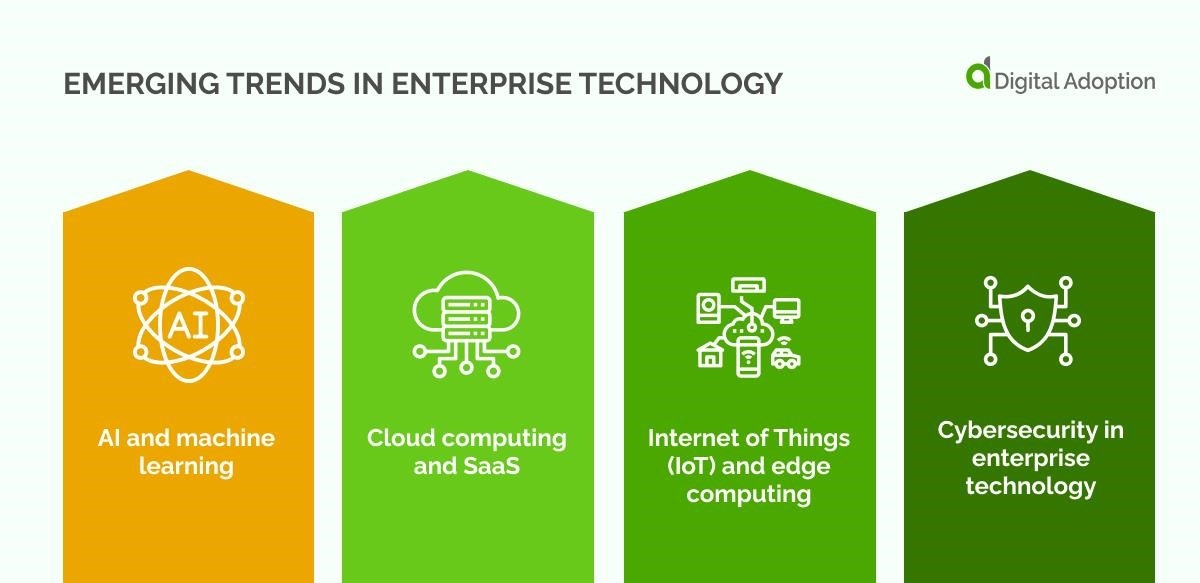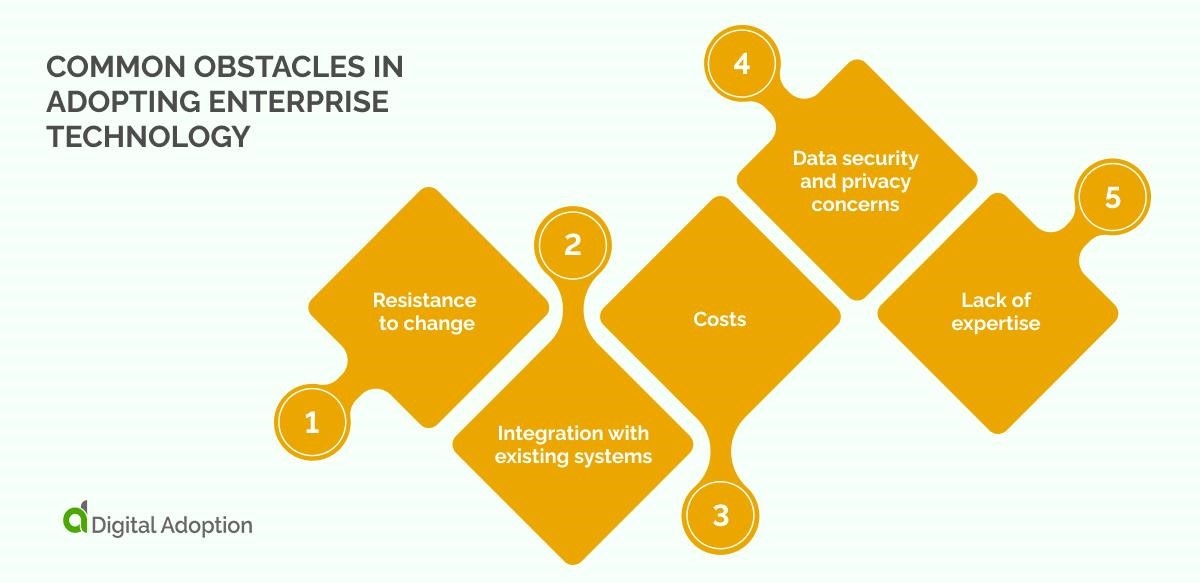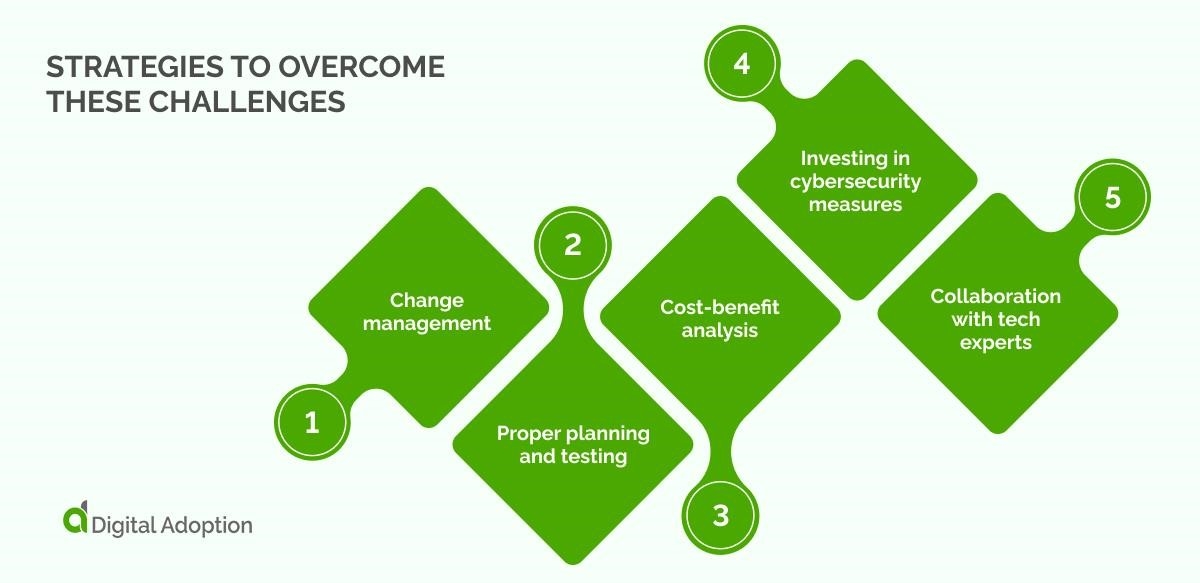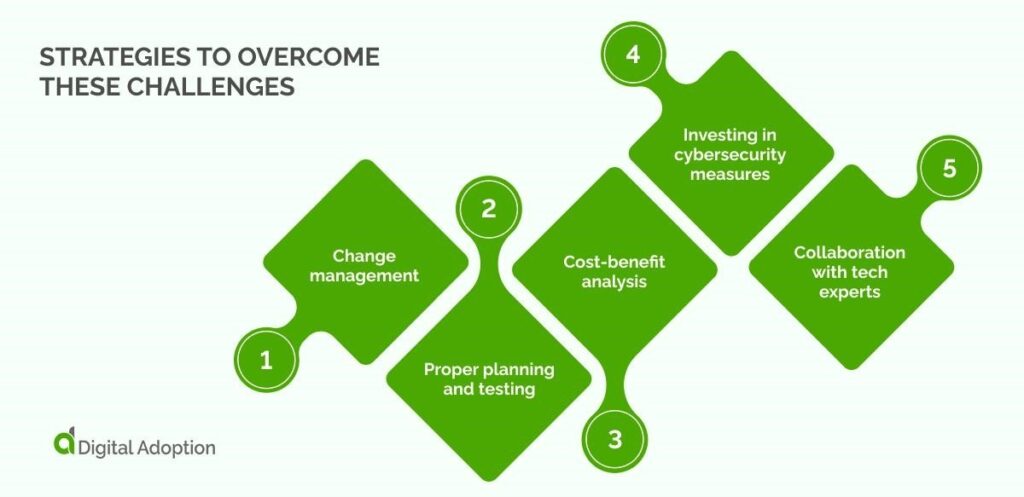Enterprise technology is the bedrock of modern businesses, encompassing the hardware and software used to achieve operational efficiency and strategic goals. It’s designed to be more cost-effective and scalable than consumer technology, allowing businesses to manage resources, streamline workflows, and ultimately drive growth.

Two Core Components of Enterprise Technology
Enterprise technology can be broadly categorized into two crucial components: Software and Hardware.
Enterprise Software
Enterprise software forms the backbone of many businesses’ IT infrastructure, driving efficiency and collaboration across departments. These complex applications are designed to integrate various business processes.
Key Types of Enterprise Software:
- ERP (Enterprise Resource Planning): ERP systems centralize the management of vital business functions such as inventory management, order processing, accounting, human resources, and customer relationship management. This real-time management ensures data consistency and streamlined workflows.
- CRM (Customer Relationship Management): CRM software focuses on managing interactions with both current and potential customers. It tracks and manages customer information, interactions, sales, and support, ultimately enhancing customer service and fostering loyalty.
- SCM (Supply Chain Management): SCM software meticulously manages the flow of goods, data, and finances throughout the entire supply chain, from raw material acquisition to final product delivery. It streamlines the process, reducing costs, improving customer service, increasing operational efficiency, and accelerating delivery times.
Enterprise Hardware
Enterprise hardware provides the physical foundation for running enterprise software and storing the vast amount of data businesses generate.
Common Types of Enterprise Hardware:
- Servers: Servers are powerful computers that provide shared resources, services, or applications to other computers (clients) over a network. In a business setting, servers host the databases and applications that power your operations and user functions.
- Data Centers: Data centers are physical facilities that house critical applications and data. These facilities are designed with redundant or backup components for power, cooling, and networking to ensure business continuity.
- Networking Hardware: Networking hardware encompasses the physical devices that enable communication and interaction between devices on a computer network. This infrastructure provides the pathway for data to travel across the network, allowing users to access and share information seamlessly. Examples include routers, switches, and firewalls.
Enterprise Technology’s Impact on the Modern Business Landscape
The role of enterprise technology in today’s business landscape is paramount. The availability of enterprise solutions often shapes what businesses deem possible, driving innovation and fueling competitive advantage.
Benefits of Enterprise Technology:
- Streamlined Operations: Enterprise software like ERP and CRM automates repetitive tasks, freeing up employee time to focus on strategic initiatives.
- Data-Driven Decision-Making: Advanced analytics and business intelligence software provide valuable insights from your data, enabling informed decision-making and predictive capabilities.
- Enhanced Collaboration: Enterprise technology facilitates seamless communication and collaboration, breaking down silos within your organization.
- Improved Customer Service: CRM and AI-powered chatbots personalize the customer experience, resolve queries swiftly, and nurture customer loyalty.
The Role of Enterprise Technology in Digital Transformation
Enterprise technology is essential for any company’s digital transformation journey. The right enterprise solution can be a make-or-break factor in a digital transformation effort, often shaping the strategic goals around available technology.
Key Contributions of Enterprise Technology in Digital Transformation:
- Innovation and Competitive Advantage: Adopting the latest enterprise technology allows you to innovate processes, products, and services, gaining a competitive edge in the marketplace.
- Scalability: Cloud computing services and modular software architectures allow businesses to scale operations up or down based on demand, leading to cost savings and improved resource management.
- Integration and Interoperability: Enterprise technology seamlessly integrates various business functions, promoting interoperability and consistency across different processes.
- Remote Work Enablement: In the era of remote work, enterprise technology empowers employees to collaborate effectively and access necessary resources from anywhere, ensuring business continuity.
Emerging Trends in Enterprise Technology

The rapid evolution of technology fuels several emerging trends in the enterprise technology landscape, significantly influencing how businesses operate. Understanding these trends can help you determine the right time to invest in new technology, potentially giving you a chance to leapfrog the competition.
Key Emerging Trends:
- AI and Machine Learning: Artificial Intelligence (AI) and Machine Learning (ML) are transforming the enterprise landscape by automating routine tasks and generating valuable insights from data. AI-driven applications streamline customer service through chatbots, improve decision-making with predictive analytics, and optimize operational efficiency through hyperautomation platforms.
- Cloud Computing and SaaS: Cloud computing and Software as a Service (SaaS) have become staples in enterprise technology. The cloud offers scalable and flexible resources that businesses can leverage to store, manage, and process data, reducing reliance on physical infrastructure and lowering IT costs. While cloud computing is prevalent, the next evolution may be industry cloud. SaaS allows businesses to access software applications over the internet on a subscription basis, offering ease of use, affordability, and access to the latest features and security measures.
- Internet of Things (IoT) and Edge Computing: The Internet of Things (IoT) refers to a network of physical devices, such as sensors, appliances, and vehicles, connected to the internet, collecting and sharing data. IoT technology allows businesses to gather real-time data, optimize operations, reduce costs, and enhance customer experiences. Edge computing, which involves processing data closer to its source, reduces latency, improves speed, and enables real-time analytics, making it especially valuable for IoT deployments.
- Cybersecurity in Enterprise Technology: Cybersecurity has become critical as businesses become increasingly digital and data-driven. Cybersecurity technologies protect enterprise systems, networks, and data from digital attacks, theft, and damage. As cyber threats become more sophisticated, businesses invest in advanced cybersecurity measures like AI-powered threat detection, blockchain for data integrity, and zero-trust security models. This proactive approach ensures the protection of sensitive business and customer data, maintains customer trust, and is essential for business and customer continuity planning.
The Challenges and Solutions in Implementing Enterprise Technology
While adopting enterprise technology presents substantial benefits, the process isn’t without challenges. Perhaps the most significant is the environmental impact of enterprise technology. According to McKinsey, in 2022, enterprise technology emitted around 350 to 400 megatons of carbon dioxide equivalent gases (CO2e), accounting for about 1 percent of total global greenhouse gas (GHG) emissions. While this may seem small, it equates to about half the emissions from aviation or shipping and is comparable to the total carbon emitted by the United Kingdom. Addressing this challenge requires industry-wide collaboration. Beyond the environmental impact, several other obstacles can arise during implementation.

Common Obstacles:
- Resistance to Change: One of the biggest barriers to adopting new technologies is employee resistance to change. This can stem from fear of the unknown, a lack of understanding of the new technology, or concerns about job security.
- Integration with Existing Systems: Incorporating new technology into existing IT systems can be complex and often poses compatibility issues.
- Costs: Implementing new enterprise technologies can be expensive, including the direct costs of purchasing the technology and indirect costs of training, maintenance, and potential downtime.
- Data Security and Privacy Concerns: With increased reliance on digital technologies, businesses are more vulnerable to cyber threats, raising concerns about data security and privacy.
- Lack of Expertise: Some businesses may lack the technical skills necessary to implement and manage new technologies effectively.

Strategies to Overcome These Challenges:
- Change Management: Successful adoption of new technologies may require a cultural shift within your organization. You can achieve this through effective change management strategies, such as transparent communication about the benefits of the new technology, providing adequate training, and involving employees in the transition process.
- Proper Planning and Testing: Prior to implementation, thoroughly plan and test the new technology in a controlled environment to ensure it integrates smoothly with existing systems.
- Cost-Benefit Analysis: Conduct a comprehensive cost-benefit analysis to understand the return on investment (ROI) that the new technology can offer. While costs cannot be avoided, this analysis can help justify the initial expenditures associated with implementation.
- Investing in Cybersecurity Measures: Prioritize investing in robust cybersecurity measures to protect sensitive data and mitigate security concerns. This includes regular security audits, employing encryption technologies, and adhering to data compliance regulations.
- Collaboration with Tech Experts: Collaborate with IT experts or third-party vendors who possess the knowledge and experience to help implement the new technology effectively. This can help fill any skill gaps in your organization and ensure the successful deployment of the new technology.
Enterprise Technology: Enabler, Payload, and Limitation All at Once
The availability of enterprise technology permeates every aspect of your business. Established enterprise solutions enable you to drive efficiency and smooth operations. Cutting-edge enterprise technology is the payload you want your digital transformation efforts to deliver. Yet, the limitations of technology can also be the biggest hindrance to progress.
Learn more about us at: javanet247
It’s essential to understand that enterprise technology is the foundation upon which modern businesses are built. Staying on top of emerging enterprise technologies and their capabilities is critical for any business leader seeking a competitive advantage.

